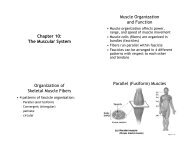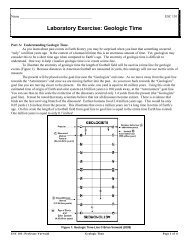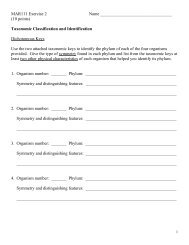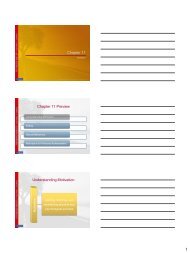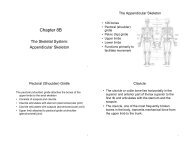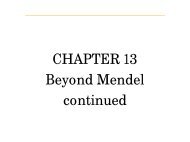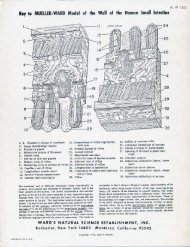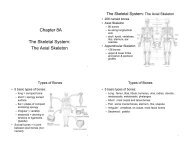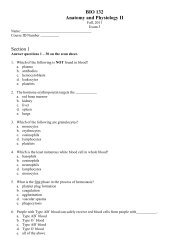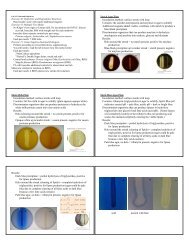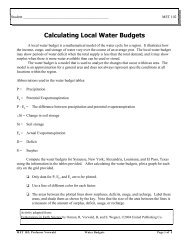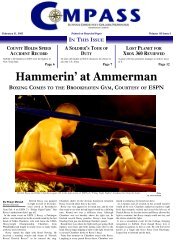Muscle Tissue (Chapter 10) - Suffolk Community College ...
Muscle Tissue (Chapter 10) - Suffolk Community College ...
Muscle Tissue (Chapter 10) - Suffolk Community College ...
You also want an ePaper? Increase the reach of your titles
YUMPU automatically turns print PDFs into web optimized ePapers that Google loves.
Thin filaments(on handout)Sliding Filament Theory-contraction of skeletal muscle is due to thickfilaments and thin filament sliding past eachother, not compression of the filaments-evidence:1. H-zones and I-bands decrease width duringcontractionThick filaments(on handout)2. Zones of overlap increase width3. Z-lines move closer together4. A-band remains constant-sliding causes shortening of every sarcomerein every myofibril in every fiber-overall result = shortening of whole skeletalmuscleEvents of <strong>Muscle</strong> ContractionA. Excitation: excitation of muscle fiber iscontrolled by nervous system at neuromuscularjunction using neurotransmitterEvents of Excitation (see handout)Neuromuscular junction(on handout)Amy Warenda Czura, Ph.D. 4 SCCC BIO130 <strong>Chapter</strong> <strong>10</strong> Lecture Notes
Tension produced in whole muscle depends on:1. Internal vs. external tensionInternal tension = produced by sarcomeres,not all transferred to load, some lost dueto elasticity of muscle tissuesExternal tension = tension applied to load2. Number of muscle fibers stimulated-each skeletal muscle has thousands of fibersorganized into motor units-Motor unit = all fibers controlled by singlemotor neuron (axon branches to contacteach fiber)-Number of fibers in motor unit depends onfunction:-fine control: 4/unit e.g. eye muscles-gross control: 2000/unit e.g. legs-Fibers from different motor units intermingledin muscle so activation of one unit willproduce equal tension across wholemuscleRecruitment = order of activation of motorunits: slower weaker first, stronger unitsadded to produce steady increase in tensionDuring sustained contraction of a muscle,some units rest while others contract toavoid fatigueFor maximum tension, all units in completetetanus but this leads to rapid fatigue<strong>Muscle</strong> tone = maintaining shape/definition ofmuscle: some units always contracting:exercise = "units contracting "metabolicrate "speed of recruitment (better tone)All contractions produce tension but notalways movement:Isotonic contractions - muscle length changesresulting in movementIsometric contractions -tension is producedwith no movementReturn to resting length: expansion via:1. elastic recoil after contraction2. opposing muscle contractions3. gravity<strong>Muscle</strong> Metabolism- 1 fiber ~15 billion thick filaments- 1 thick filament ~ 2500 ATP/sec- 1 glucose (aerobic respiration) = 36 ATP- each fiber needs 1 X<strong>10</strong> 12 glucose/sec tocontract- ATP unstable, muscles store respirationenergy on creatine as CreatinePhosphate (CP)-Creatine phosphokinase transfers P from CPto ADP when ATP needed to resetmyosin for next contraction-Each cell has only ~20sec energy reserveAt Rest: use glucose and fatty acids with O 2(from blood) !Aerobic respiration,resulting ATP used to build CPreserves, excess glucose stored asglycogen.Moderate Activity: CP used up, glucose andfatty acids with O 2 (from blood) used togenerate ATP (aerobic respiration).High Activity: O 2 not delivered adequately,glucose from glycogen reserves used forATP via fermentation (glycolysis only),pyruvic acid converted to lactic acidAmy Warenda Czura, Ph.D. 7 SCCC BIO130 <strong>Chapter</strong> <strong>10</strong> Lecture Notes
<strong>Muscle</strong> Fatigue:-state where muscle can no longer contractdue to:1. Depletion of reserves (glycogen, ATP, CP)2. Decreased pH due to lactic acidTo restore function, cell needs:1. intracellular energy reserves (glycogen, CP)2. good circulation (nutrients in, wastes out)3. normal O 2 levels4. normal pHLactic Acid Disposal-lactic acid diffuses into blood-filtered out by liver-converted back to glucose-returned to blood for use by cells-when O 2 returns, remaining lactic acid inmuscle is converted to glucose and usedin aerobic cellular respiration<strong>Muscle</strong> Performance-Depends on:1. Types of fibers2. Physical conditioning1. Fiber Types-types of fibers in a muscle are geneticallydetermined and mixedA. Fast glycolytic fibers (Fast twitch)-Myosin ATPases work quickly-anaerobic ATP production(glycolysis only)-large diameter fibers-more myofilaments and glycogen-few mitochondria-fast to act, powerful, but quick to fatigue-catabolize glucose onlyB. Slow oxidative fibers (slow twitch)-Myosin ATPases work slowly-specialized for aerobic respiration:-many mitochondria-extensive blood supply-myoglobin-smaller fibers for better diffusion-slow to contract, weaker tension, but resistfatigue-catabolize glucose, lipids, and amino acidsC. Intermediate/ Fast oxidative fibers-qualities of both fast glycolytic andslow oxidative fibers-fast acting but perform aerobic respirationso resist fatigue-physical conditioning can convert somefast fibers into intermediate fibers forstamina2. Physical ConditioningA. Aerobic Exercise:" capillary density" mitochondria and myoglobinboth then:" efficiency of muscle metabolism" strength and stamina# fatigueB. Resistance Exercise:-results in hypertrophy: fibers increasein diameter but not number-"glycogen, myofibrils, and myofilamentsresults in "tension productionGrowth Hormone (pituitary) & testosterone(male sex hormone) stimulate synthesis ofcontractile proteins = muscle enlargementEpinephrine stimulates "muscles metabolism= " force of contractionWithout stimulation muscles will atrophy:fibers shrink due to loss of myofilamentproteins. Loss: up to ~5%/dayAmy Warenda Czura, Ph.D. 8 SCCC BIO130 <strong>Chapter</strong> <strong>10</strong> Lecture Notes
Cardiac <strong>Muscle</strong> <strong>Tissue</strong>-forms the majority ofheart tissue-cells = cardiocytes-one or two nuclei-no cell division-long branched cells-myofibrils organizedinto sarcomeres (striated)-no triads (no terminal cisternae)-transverse tubules encircle Z-lines-aerobic respiration only-mitochondria and myoglobin rich-glycogen and lipid energy reserves-intercalated discs at cell junctions (gapjunctions and desmosomes) allowtransmission ofaction potentials& linkmyofibrils fromone cell to nextFeatures of cardiac muscle:1. Can contract without neural stimulation;automaticity due to pacemaker cells thatgenerate action potentials spontaneously2. Pace and amount of tension can be adjustedby nervous system3. Contractions <strong>10</strong>X longer than skeletalmuscle4. Only twitches, no complete tetanusSmooth <strong>Muscle</strong> <strong>Tissue</strong>-lines hollow organs: regulates blood flow andmovement of materials in organs-forms arrector pili muscles-usually organized into two layers:-circular-longitudinal-spindle shaped cells-central nucleus-cells capable of division-no myofibrils, sarcomeres, or T tubules-SER / SR throughout cytoplasm-thick filaments scattered-thin filaments attached to dense bodies ondesmin cytoskeleton (web)-adjacent cells attach at dense bodies with gapjunctions (firm linkage and communication)-no tendons-contractioncompresseswhole cellSmooth <strong>Muscle</strong> Excitation-Contraction-different than striated muscle: no troponin soactive sites on actin always exposedEvents:1. Stimulation causes Ca 2+ release from SRinto cytoplasm2. Ca 2+ binds calmodulin3. Calmodulin activates myosin light chainkinase4. MLC Kinase converts ATP ! ADP to cockmyosin head5. Cross bridges form ! contraction, cellspull toward centerStimulation is by involuntary control from:-Autonomic Nervous System-hormones-other chemical factors(Skeletal muscle = motor neurons)(Cardiac muscle = automaticity)Amy Warenda Czura, Ph.D. 9 SCCC BIO130 <strong>Chapter</strong> <strong>10</strong> Lecture Notes
Effects of aging-skeletal muscle fibers become thinner#myofibrils, #energy reserves =#strength #endurance "fatigue-#cardiac and smooth muscle function =#cardiovascular performance-"fibrosis (CT)skeletal muscle less elastic-#ability to repair#satellite cells"scar formationAmy Warenda Czura, Ph.D. <strong>10</strong> SCCC BIO130 <strong>Chapter</strong> <strong>10</strong> Lecture Notes



